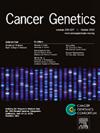基于ssGSEA富集评分的胶质母细胞瘤免疫预后模型
IF 2.1
4区 医学
Q4 GENETICS & HEREDITY
引用次数: 0
摘要
目的基于肿瘤免疫微环境(tumor immune microenvironment, TIME)的恶性胶质瘤预后预测模型尚未见报道。因此,本研究旨在通过分析肿瘤中丰富的生物学过程和途径,构建胶质母细胞瘤的免疫预后模型。方法利用TCGA RNA测序数据对141例胶质母细胞瘤患者分子特征数据库中的基因集进行单样本基因集富集分析(ssGSEA)。在使用单变量Cox回归评估与预后相关的基因集后,提取胶质瘤中与生物过程和肿瘤免疫相关的基因集。最后,利用最小绝对收缩算子和选择算子Cox回归对基因集进行细化,并构建了模态图。该模型使用CGGA(183例)和爱知县癌症中心(42例)数据集进行验证。结果免疫预后模型包括三个与生物过程相关的基因集(鞘脂、类固醇激素和中间丝)和一个与肿瘤免疫相关的基因集(涉及肿瘤相关小胶质细胞和巨噬细胞的免疫抑制趋化因子途径)。训练(TCGA)和验证(CGGA)队列的Kaplan-Meier曲线显示,与低风险组相比,高危组的总生存率显著降低(p <;0.001和p = 0.04)。此外,硅细胞术显示高危组中具有免疫抑制特性的巨噬细胞和具有效应功能的T细胞显著增加(p <;0.01)。结论利用ssGSEA构建基于TIME评估的免疫预后模型,可为胶质母细胞瘤患者的预后和免疫特征提供有价值的见解,并指导治疗策略。本文章由计算机程序翻译,如有差异,请以英文原文为准。
Immune prognostic model for glioblastoma based on the ssGSEA enrichment score
Purpose
Few effective immune prognostic models based on the tumor immune microenvironment (TIME) for glioblastoma have been reported. Therefore, this study aimed to construct an immune prognostic model for glioblastoma by analyzing enriched biological processes and pathways in tumors.
Methods
A comprehensive single-sample gene set enrichment analysis (ssGSEA) of gene sets from the Molecular Signatures Database was performed using TCGA RNA sequencing data (141 glioblastoma cases). After evaluating gene sets associated with prognosis using univariable Cox regression, gene sets related to biological processes and tumor immunity in gliomas were extracted. Finally, the least absolute shrinkage and selection operator Cox regression refined the gene sets and a nomogram was constructed. The model was validated using CGGA (183 cases) and Aichi Cancer Center (42 cases) datasets.
Results
The immune prognostic model consisted of three gene sets related to biological processes (sphingolipids, steroid hormones, and intermediate filaments) and one related to tumor immunity (immunosuppressive chemokine pathways involving tumor-associated microglia and macrophages). Kaplan-Meier curves for the training (TCGA) and validation (CGGA) cohorts showed significantly worse overall survival in the high-risk group compared to the low-risk group (p < 0.001 and p = 0.04, respectively). Furthermore, in silico cytometry revealed a significant increase in macrophages with immunosuppressive properties and T cells with effector functions in the high-risk group (p < 0.01) across all cohorts.
Conclusion
Construction of an immune prognostic model based on the TIME assessment using ssGSEA could potentially provide valuable insights into the prognosis and immune profiles of patients with glioblastoma and guide treatment strategies.
求助全文
通过发布文献求助,成功后即可免费获取论文全文。
去求助
来源期刊

Cancer Genetics
ONCOLOGY-GENETICS & HEREDITY
CiteScore
3.20
自引率
5.30%
发文量
167
审稿时长
27 days
期刊介绍:
The aim of Cancer Genetics is to publish high quality scientific papers on the cellular, genetic and molecular aspects of cancer, including cancer predisposition and clinical diagnostic applications. Specific areas of interest include descriptions of new chromosomal, molecular or epigenetic alterations in benign and malignant diseases; novel laboratory approaches for identification and characterization of chromosomal rearrangements or genomic alterations in cancer cells; correlation of genetic changes with pathology and clinical presentation; and the molecular genetics of cancer predisposition. To reach a basic science and clinical multidisciplinary audience, we welcome original full-length articles, reviews, meeting summaries, brief reports, and letters to the editor.
 求助内容:
求助内容: 应助结果提醒方式:
应助结果提醒方式:


